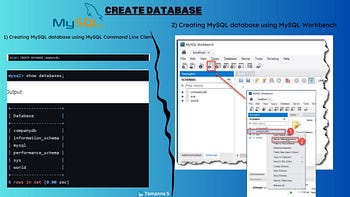“Unlocking Data Potential: A Beginner’s Guide (Part-3)to MySQL Database Mastery”

Welcome to the MySQL Beginners Series — your gateway to mastering database management.
In the digital age, data is the new gold, and managing it efficiently is crucial for any business or individual looking to thrive. MySQL, a robust and widely used database management system, stands as a beacon of reliability and ease, especially for those just starting their journey in database administration or developer etc.
Introduction to Managing Databases in MySQL:
Managing a database in MySQL is akin to organizing a library. Just as a librarian categorizes books, you’ll be categorizing data — making it easily accessible, manageable, and secure.
Imagine a world where data is not just numbers and text but the lifeblood of technology, driving innovation and decision-making. That’s the world MySQL empowers you to navigate. In this series, we’ll cover the essentials of database management, ensuring you have the knowledge to create, select, and maintain your databases effectively.
Creating a Database: Your First Command
The CREATE DATABASE command is your initiation into the world of MySQL. It’s the digital equivalent of laying the first brick of your data fortress.
You can create a database in MySQL in two methods:
- Using MySQL Command Line Client
- Using MySQL Workbench

Selecting a Database: Entering Your Data Realm
With the USE command, you select your database, much like choosing a book from a shelf, ready to immerse yourself in its contents.

Renaming a Database: A New Identity
MySQL challenges you to think creatively, as renaming a database requires a workaround. It’s a test of your problem-solving skills, ensuring you’re prepared for real-world scenarios.

Showing Databases: The Overview
SHOW DATABASES is your command to list all databases at your disposal, offering a bird’s-eye view of your data kingdom.

Copying a Database: Duplication for Safety
Copying a database is a safeguarding strategy, ensuring that your valuable data is preserved and replicated for continuity.

Dropping a Database: The Clean Slate
The DROP DATABASE command is the ultimate reset button, clearing the way for new structures and opportunities.

Why Database Management Matters?
Efficient database management is the cornerstone of technological proficiency. It’s about harnessing the chaos of data and turning it into structured, accessible, and secure information.

Conclusion: A Journey Well Begun
We’ve navigated the foundational aspects of managing databases in MySQL, setting the stage for a deeper exploration in future installments of this series.
Stay Connected and Show Your Support
If this guide has illuminated the path of database management for you, consider following my journey on LinkedIn and applauding 👋 this post. Your engagement is the fuel for this educational voyage.
A Parting Thought
“In the garden of technology, data is the seed, and database management is the art of ensuring it blossoms.” — As we continue our MySQL for Beginners series, remember that managing your database is not just a task, it’s a craft.
Comments
Post a Comment